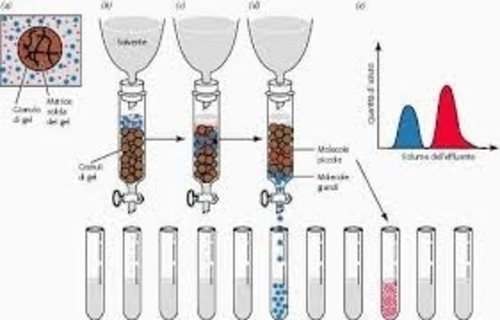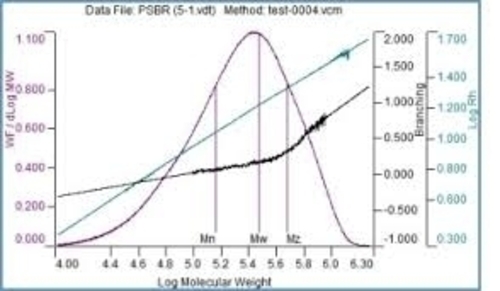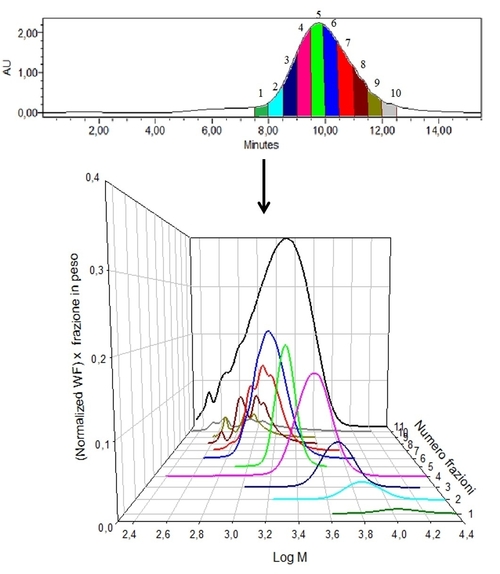Analysis by HPLC chromatograph are carried out with a gradient pump (waters 1510), refractive index detectors (Waters 2414) and diode arrays (DAD-Waters Mod 2996) for the qualitative and quantitative determination of organic compounds. Quantitative and qualitative analysis are performed with Water Empower software on C18 columns at different polarities both in aqueous phase and in organic solvents.
Note: HPLC-MS analyses can be performed on request for the identification of monomers and additives contained in industrial polymers.
Chromatographic analyses
HPLC analysis with multidetector chromatographic system (B.1-hplc)

Size Exclusion Chromatography (SEC) with triple detector (B.2-sectd)

The SEC-TD chromatographic system if formed by a Knauer isocratic (mod K501) and refractive index detector (RI knauer mod 2300) combined with triple detector (TD - Viscotek mod TD270) consisting of differential viscometer (DP), analyzer two-angle (90 ° and 7 °) diffused light (LS) and two eluted mixed columns with THF at 1 ml / min. By combining the chromatograms obtained with the various detectors with OmniSEC v.5.1 (Viscotek) software, it is possible to determine the distribution of molecular weights from which to calculate the statistical averages (Mn, Mw) and polydispersity (IPD) with conventional calibration methods , universal and absolute. The behavior of viscosity according to molecular weights also allows to determine the Mark-Houwink constants, the degree of branching and the intrinsic viscosity.
Methods applied:
ISO 16014-1: 2012 General principles
ISO 16014-2: 2012 Determination of average molecular mass and molecular mass distribution of polymers by using size exclusion chromatography - Part 2: Universal calibration method
ISO 16014-3: 2012 Determination of average molecular mass and molecular mass distribution of polymers by using size exclusion chromatography - Part 3: Low temperature method with conventional calibration method using standards
ISO 16014-5: 2012 Determination of average molecular mass and molecular mass distribution of polymers by using size exclusion chromatography - Part 5: Light scattering detection method
Also possible cod. B.2A "Size Exclusion Chromatography (SEC) with triple detector with HFIP eluent"
GPC analysis with triple detector in water solution (B.3-sectdaq)
The Size exclusion chromatography (SEC) system is formed by a isocratic Knauer pump (Mod K501) and refractive index detector (RI knauer mod 2300) combined with triple detector (mod. TD 270 - Viscotek) consisting of differential viscometer (DP) and light analyzer (90 ° and 7 °) and two columns (Agilent aquagel) eluted with water milliQ + 0.1% NaNO3 with 1 ml / min. By combining the chromatograms obtained with the various detectors with OmniSEC (Viscotek) software, it is possible to determine the molecular weight distribution curves from which to calculate the statistical averages (Mn, Mw and IPD) with conventional, universal and absolute calibration methods. The behavior of viscosity according to molecular weights also allows to determine the Mark-Houwink constants, the degree of branching and the intrinsic viscosity.
NB:: Other eluents are also available when cationic or anionic groups are present into water soluble macromolecules to avoid aggreagates.
SEC-semipreparative analysis (B.4-secsemiprep)

The chromatographic system for SEC-semipreparative is fomed by a Waters isocratic (Mod 1525) and UV detector (Waters 2487), Agilent semipreparative column eluted at 8 ml / min with organic solvents (CH2Cl2, THF, ...) and fractional collector Waters mod WFC III) to 100 positions. The chromatographic system is operated by 'Clarity' software to determine the collection of fractions to be isolated after column splitting. The maximum number of fractions varies depending on the type of polydisperse polymer used in the separation. Each fraction, after solvent evaporation under the reduced pressure, can be used for the following analyses:
i) Chromatographic (eg SEC-TD and HPLC)
ii) Spectroscopic (1H & 13 C NMR)
iii) Mass Spectrometry and MALDI
iv) FTIR / FTNIR spectroscopy
Moreover, the obtained fractions can be used, after calibration with SEC-TD, as the known standard molecular weight of the fractionated polydispolymer to be used with a conventional SEC chromatographic system as a valid alternative to polystyrene commercial grade standards.
Note: on request you can:
i) obtain at least 10 standard molecular weight known by calibration with SEC-TD from a polydisperse polymer of industrial interest
ii) to study the sequences in MALDI spectrometry branched copolymers and polymers

